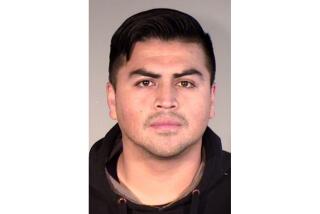Cathedral’s Site a Legal Battleground
The downtown site chosen by Cardinal Roger M. Mahony for Los Angeles’ new $50-million cathedral was, for more than 10 years in the 1940s and ‘50s, a legal battleground for a colorful criminal defense attorney who fought the county over the land, but who wanted to be remembered as, in his words, “the attorney for the damned.”
Morris Lavine sold his half of the 5.5 acres to Los Angeles County, then spent seven years in court trying to force the county to use the land for its intended purpose, a new courthouse. But he was better known for clients from Frank Sinatra Jr.’s kidnappers to mobsters such as Mickey Cohen.
At age 14, the Cleveland native was already writing for Los Angeles newspapers. By the time he graduated from law school at 20, he spoke four languages.
*
As a Navy officer in World War I, he acted as defense attorney in 300 courts-martial, but his newspaper experiences lured him back to journalism after the war. As a Los Angeles Examiner reporter, he trumped the competition in 1923 when he persuaded escaped convict Clara Phillips, the “Tiger Woman” murderer of her husband’s lover, to return from Honduras.
Lavine’s glory lasted until 1930, when he was accused of hatching a scheme to extort $75,000 from a trio of organized crime figures in exchange for keeping their names out of a story about fraudulent oil promotion schemes.
Then one witness died of lockjaw and, after closing arguments, the deputy district attorney went home and died in his sleep. That jury was hung. Another jury found Lavine guilty after a second trial.
After 10 months in jail, Lavine wrote and won his own appeal. Five years later, he received a full pardon from the governor and was reinstated as a lawyer.
His courtroom career was often as colorful as those of the men he defended--Teamsters chief Jimmy Hoffa and alleged Mafioso John Roselli, as well as such memorable convicted murderers as L. Ewing Scott, Louise Peete and Major Raymond Lisenba, alias Rattlesnake James, nicknamed for his preferred murder weapon.
After Lavine got Cohen released from prison in 1951 pending appeal of an income tax conviction, Cohen threw his short arms around Lavine’s neck and said, “It’s wonderful, Morrie--wonderful, wonderful!” and kissed Lavine on the cheek.
The other case that won Lavine wide renown was representing the men convicted of kidnapping Frank Sinatra Jr. from a Lake Tahoe hotel in 1963 for $240,000 ransom. He won an appeal for one of the three. Then, when his colleague Gladys Towles Root was indicted for falsely claiming that young Sinatra let himself be kidnapped as a publicity stunt, Lavine got her indictment overturned.
Lavine made his mark as an appellate lawyer, defending clients vehemently with precedent and legal principles; in his career, he wrote more than a thousand appeals. (One judge still remembers him for citing his own successful cases as precedent in court.)
Two of those appeals, made pro bono on behalf of indigents, resulted in landmark U.S. Supreme Court decisions in 1965 and 1967 prohibiting prosecutors from drawing inferences of guilt from a defendant’s refusal to testify.
*
But it was his half of the sloping downtown parcel of land he inherited from his mother in the 1930s that was at the center of one of Lavine’s longest cases.
In 1947, the county Board of Supervisors condemned the land to put up a courthouse, and paid Lavine and the co-owner about $60,000 each.
But when the county instead moved the courthouse site to 1st and Hill streets, Lavine’s battle began. First he sued on behalf of himself and lost. Then taxpayers sued, charging officials with conspiracy, fraud, misrepresentation, gross negligence and wasting $2.2 million in condemning the property, and blamed them for needlessly ousting tenants from the aging Victorian houses on the land.
While bulldozers attacked millions of cubic yards of earth to turn the property into a parking lot, Lavine carried the taxpayers’ fight all the way to the Supreme Court--and lost.
It wasn’t for another 10 years, when a barrio in Chavez Ravine was razed to make way for Dodger Stadium, that a comparable incident would rock the city.
Lavine’s peers honored him in 1956, naming him president of the local Criminal Courts Bar Assn., succeeding another legendary attorney, Jerry Giesler.
The champion of appellate matters, who argued principles as passionately as others argued personalities, died in 1982 at age 86.
More to Read
Sign up for Essential California
The most important California stories and recommendations in your inbox every morning.
You may occasionally receive promotional content from the Los Angeles Times.










